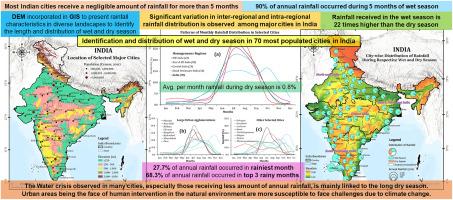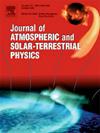Identification and distribution of wet and dry season in the 70 most populated cities in India
IF 1.9
4区 地球科学
Q3 GEOCHEMISTRY & GEOPHYSICS
Journal of Atmospheric and Solar-Terrestrial Physics
Pub Date : 2025-09-26
DOI:10.1016/j.jastp.2025.106649
引用次数: 0
Abstract
In this paper, for the first time, we have attempted to identify the length and distribution of the wet and dry season of the 70 most populated cities in India based on the relative intra-annual distribution of rainfall observed during the last three decades (1991–2020). The wet season in the cities under investigation is rather continuous and usually lasts for 4–8 months. The distribution of the wet months however indicates significant variation, particularly for the cities located in the southern and northern periphery of the country. The cities located in the remaining areas even though have been receiving rainfall primarily during the Indian Summer Monsoon (ISM), the length of the wet season however varies among them. The present study also highlights that the average length of the wet season in India is not always four months; instead, it is a little over 5 months long in general. The length and distribution of the dry season also indicate that most cities receive a very negligible amount of rainfall for more than five months. The average amount of rainfall received by the cities during their respective dry season (4.1 %) is about 22 times lower than the average amount of rainfall received during their respective wet season (90.2 %). Noticeable variation in the amount of annual rainfall, length of dry and wet season, and amount of rainfall received in their respective wet and dry season among cities within each of the four homogeneous regions is also a significant finding of the present work.

印度70个人口最多的城市的湿季和旱季的识别和分布
在本文中,我们首次尝试根据过去三十年(1991-2020年)观测到的降雨量的相对年内分布,确定印度70个人口最多的城市的干湿季节的长度和分布。被调查城市的雨季相当持续,通常持续4-8个月。然而,湿润月份的分布显示出显著的变化,特别是位于该国南部和北部边缘的城市。位于其余地区的城市虽然主要在印度夏季风(ISM)期间降雨,但雨季的长度在它们之间有所不同。目前的研究还强调,印度雨季的平均长度并不总是四个月;相反,它通常是5个多月的时间。旱季的长度和分布也表明,大多数城市在五个多月的时间里降雨量非常小。各城市在旱季的平均降雨量(4.1%)比其在雨季的平均降雨量(90.2%)低约22倍。在四个均匀区域内的城市之间,年降雨量、干湿季节长度以及各自干湿季节的降雨量的显著变化也是本工作的一个重要发现。
本文章由计算机程序翻译,如有差异,请以英文原文为准。
求助全文
约1分钟内获得全文
求助全文
来源期刊

Journal of Atmospheric and Solar-Terrestrial Physics
地学-地球化学与地球物理
CiteScore
4.10
自引率
5.30%
发文量
95
审稿时长
6 months
期刊介绍:
The Journal of Atmospheric and Solar-Terrestrial Physics (JASTP) is an international journal concerned with the inter-disciplinary science of the Earth''s atmospheric and space environment, especially the highly varied and highly variable physical phenomena that occur in this natural laboratory and the processes that couple them.
The journal covers the physical processes operating in the troposphere, stratosphere, mesosphere, thermosphere, ionosphere, magnetosphere, the Sun, interplanetary medium, and heliosphere. Phenomena occurring in other "spheres", solar influences on climate, and supporting laboratory measurements are also considered. The journal deals especially with the coupling between the different regions.
Solar flares, coronal mass ejections, and other energetic events on the Sun create interesting and important perturbations in the near-Earth space environment. The physics of such "space weather" is central to the Journal of Atmospheric and Solar-Terrestrial Physics and the journal welcomes papers that lead in the direction of a predictive understanding of the coupled system. Regarding the upper atmosphere, the subjects of aeronomy, geomagnetism and geoelectricity, auroral phenomena, radio wave propagation, and plasma instabilities, are examples within the broad field of solar-terrestrial physics which emphasise the energy exchange between the solar wind, the magnetospheric and ionospheric plasmas, and the neutral gas. In the lower atmosphere, topics covered range from mesoscale to global scale dynamics, to atmospheric electricity, lightning and its effects, and to anthropogenic changes.
 求助内容:
求助内容: 应助结果提醒方式:
应助结果提醒方式:


